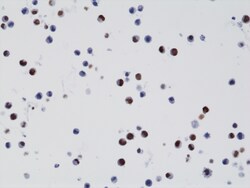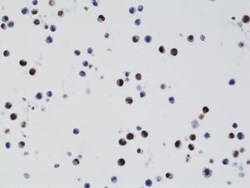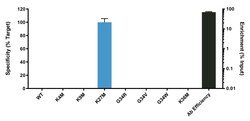MA5-27916
antibody from Invitrogen Antibodies
Targeting: H3-3B
H3.3B, H3F3B
 Western blot
Western blot ELISA
ELISA Immunocytochemistry
Immunocytochemistry Immunohistochemistry
Immunohistochemistry Chromatin Immunoprecipitation
Chromatin Immunoprecipitation Other assay
Other assayAntibody data
- Antibody Data
- Antigen structure
- References [0]
- Comments [0]
- Validations
- Immunocytochemistry [2]
- Chromatin Immunoprecipitation [1]
- Other assay [1]
Submit
Validation data
Reference
Comment
Report error
- Product number
- MA5-27916 - Provider product page

- Provider
- Invitrogen Antibodies
- Product name
- H3.3 K27M oncohistone mutant Recombinant Rabbit Monoclonal Antibody (RM192), ChIP-Verified
- Antibody type
- Monoclonal
- Antigen
- Synthetic peptide
- Description
- Recombinant rabbit monoclonal antibodies are produced using in vitro expression systems. The expression systems are developed by cloning in the specific antibody DNA sequences from immunoreactive rabbits. Then, individual clones are screened to select the best candidates for production. The advantages of using recombinant rabbit monoclonal antibodies include: better specificity and sensitivity, lot-to-lot consistency, animal origin-free formulations, and broader immunoreactivity to diverse targets due to larger rabbit immune repertoire. Click here for Master Lot linking information.
- Reactivity
- Human
- Host
- Rabbit
- Isotype
- IgG
- Antibody clone number
- RM192
- Vial size
- 100 μL
- Concentration
- 0.25 mg/mL
- Storage
- -20°C
No comments: Submit comment
Supportive validation
- Submitted by
- Invitrogen Antibodies (provider)
- Main image

- Experimental details
- Immunocytochemistry analysis of Histone H3 (K27M mutant) in paraffin embedded 293T cells. Sample was incubated with Histone H3 (K27M mutant) monoclonal antibody (Product # MA5-27916) using a dilution of 0.01 µg/mL.
- Submitted by
- Invitrogen Antibodies (provider)
- Main image

- Experimental details
- Immunocytochemistry analysis of H3.3K27M on formalin fixed and paraffin embedded 293T cells transfected with a DNA construct encoding Histone H3 K27M mutant, stained with H3.3 K27M oncohistone mutant Recombinant Monoclonal antibody (Product # MA5-27916).
Supportive validation
- Submitted by
- Invitrogen Antibodies (provider)
- Main image

- Experimental details
- OncoStat Panel, SNAP-ChIP™ Spike-in (Product # A47343), a proprietary technology developed by EpiCypher™ was used to analyze the performance of H3.3 K27M antibody (Product # MA5-27916) in ChIP. SNAP-ChIP panels consist of a pool of DNA-barcoded recombinant nucleosomes harboring histone mutations that are spiked-in to a ChIP reaction to assess efficiency and specificity of the antibody. The OncoStat panel includes an unmodified H3.3 control plus nucleosomes containing H3.3 mutations (K4M, K9M, K27M, G34R, G34V, G34W and K36M) as shown on the x-axis. Recovery of each unique DNA-barcoded nucleosome is quantified to determine how much of each PTM is immunoprecipitated in the ChIP reaction (for more information see reference). H3.3 K27M antibody was tested in native ChIP with 3 µg K-562 cell chromatin and 3 µg antibody. Specificity (left Y-axis) was determined by qPCR to each modified nucleosome in the panel (X-axis). Black bar represents antibody efficiency (right Y-axis; log scale) and indicates percentage of the barcoded nucleosome target immunoprecipitated relative to Input. All bars represent mean ± SEM.
Supportive validation
- Submitted by
- Invitrogen Antibodies (provider)
- Main image

- Experimental details
- Antibody specificity was demonstrated by detection of enrichment of the targeted histone modification using SNAP-ChIP™ Spike-in, a proprietary technology developed by EpiCypher™. SNAP-ChIP™ spike-in was performed using H3.3 K27M Recombinant Rabbit Monoclonal Antibody (Product # MA5-27916) and H3.3 K27M was enriched compared to the other histone modifications in the SNAP-ChIP™ OncoStat Panel (Product # A47343).
 Explore
Explore Validate
Validate Learn
Learn